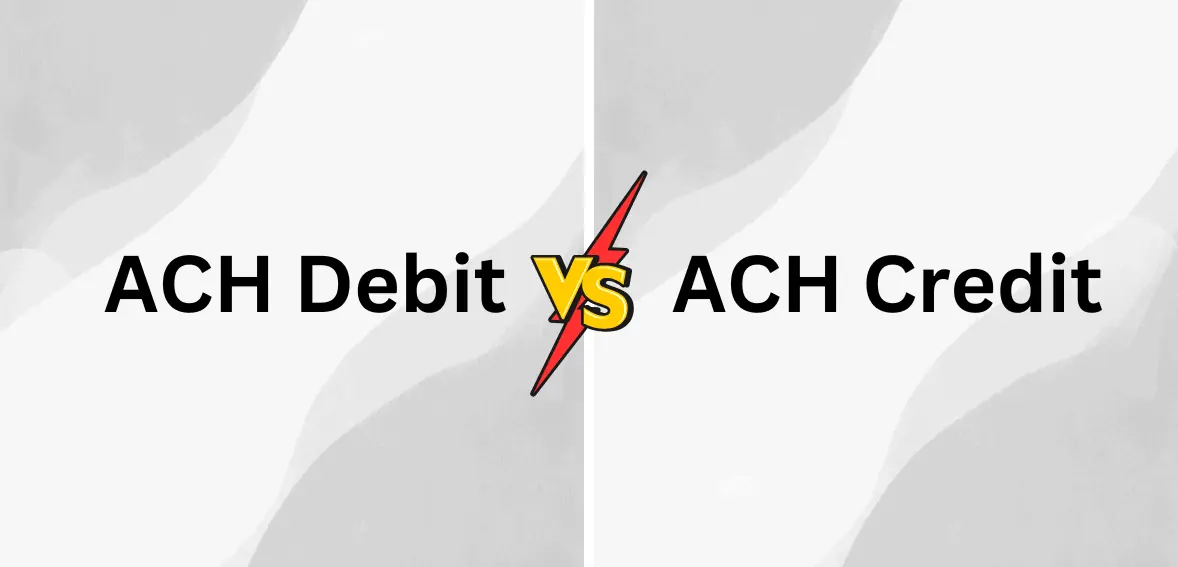The Automated Clearing House (ACH) network links more than 25,000 banking institutions nationwide and enables the electronic transfer of funds between accounts. Businesses can accept ACH credit and debit transfers.
We need to know both accounts before we get into the details of ACH Debit vs. ACH Credit. ACH credits account for about 40% of all payments in the USA. The total is increasing as more employers reimburse their employees for their direct deposits. 82% of US employees use direct deposit and ACH credit, up from 74% in 2011. Employees prefer ACH over checks because, according to a questionnaire by NACHA, it offers them faster access to funds, costs nothing, and is a more practical solution.
The sender of funds (often a bank) initiates an ACH credit transaction, while the receiver initiates an ACH debit transaction, in which the bank receives a payment request from the payee and subsequently sends the money on demand. Each type of transaction has a purpose, depending on your payment requirements.
Much of the money movement today, from wages to bills, depends on ACH credit. As NACHA’s Same-Day ACH target takes shape in the next two years, ACH transactions will become significantly more efficient, convenient, and perhaps more popular.
ACH Debit vs. ACH Credit – A Complete Explainer?
An ACH credit transfers money from one account to another. In other words, the client initiates the money transfer to the merchant or other recipient. For instance, if someone pays for things with one’s bank account, the money that moves through is an ACH credit.
ACH debit is another transfer option that enables a withdrawal from a financial account to handle payment efforts. In this process, a customer allows the retailer to deduct payment from the customer’s account whenever it is due. For instance, an ACH debit works when a person makes a recurring monthly payment for a bill, and his bank account is debited automatically.
How Do You Use ACH Debit?

The payee begins a withdrawal from the ACH by requesting the Automated Clearing House to withdraw money from one’s account. The clearinghouse manages everything from outgoing account payments to incoming account payments. All you need to conduct a transaction is account information for both bank accounts.
How Does ACH Credit Work?
An ACH credit transfer works likewise, except that the payer initiates the payment this time. The payer deposits money into the deposit account receivable. When an enterprise pays an invoice via the Automated Clearing House, the payment works with a credit that moves to the payee’s account. You can pay with ACH credits as well as opposed to getting payments. For example, you can set up automatic bill payments or mortgage payments with your bank. Another example is business owners who want to pay state taxes using ACH credits. While the word “credit” contains pictures of credit card transactions, the preceding examples show how an ACH credit can help.
Is Your Business Good With ACH Credit or ACH Debit?
The ACH system offers your organization several payment alternatives, including utility bills, rental payments, invoicing, and credit card payments.
The first criterion is that the payee has a US bank account. The ACH network does not support foreign banking institutions. A company must utilize a different method for cross-border payments. The good news is that numerous technological options are available when an ACH deal cannot work. Some of the examples of these are wire transfers and virtual payment platforms.
Compared to domestic wire transfers, ACH transfers make payments in the USA convenient. A team can also save money when accepting these payments. Recurrent ACH transfers for payments and credits can also be arranged as necessary. This “set and forget” strategy provides convenience that you won’t find in older payment methods.
In several instances, the ACH network may not be the ideal option for your firm. For example, ACH transactions do not allow you to obtain incentives. Several corporate credit cards offer this convenient service. Points can be purchased and used for many things, including travel and lodging payments.
ACH debits and credits are an easy way to send and receive payments. They frequently offer advantages over traditional payment systems, but a company may want to consider alternative electronic transfers in some cases.
How a Direct Deposit Compares With ACH Debit
A direct deposit will work through the ACH network to complete the payment process. ACH debits are a kind of direct payment. The major distinction between direct deposits and ACH debits is that the former includes a transfer of money, and the latter requires a collection of money.
Comparing An eCheck With ACH
The phrases eCheck and ACH debit may be used interchangeably. The word “ACH debit” refers to all sorts of ACH debits. E-Check is a subset of SEC codes, enabling traders to convert paper checks into electronic checks for their convenience.
How Long Do You Take ACH Credit and Debits?

ACH credits and debits are available only on open days and often take several days.
Nacha built Same Day ACH, despite how ACH payments are not like wire transfers in real-time, to address the pace of ACH credits and debits.
These dates were based on the limits imposed by Nacha, but the recipient bank may have a waiting period once the receiving bank receives the funds, leading to varying total delivery times. The Federal Reserve sponsored city hall meetings in 2018 to discuss the viability of a real-time gross settlement system.
How a Withdrawal From ACH Works
ACH withdrawals usually involve payment and purchase of online bills.
When you submit your bank account and your ACH debit routing number, the money will be debited from your account once you give your ACH withdrawal account and routing number.
An ACH withdrawal may be associated with online transactions such as the payment of bills or purchases. The process provides a convenient approach to handling charges.
Key Steps in ACH Withdrawal
- Authorization: The process begins with the account holder providing consent or authorization to the payee wishing to initiate an ACH debit. This authorization, which can be given online, in writing, or over the phone, allows the payee to pull funds from the account holder’s bank account. It must specify the amount and, in the case of recurring debits, the frequency of withdrawals.
- Initiation by the Payee: Once authorization is received, the payee initiates the ACH debit transaction through their bank, the Originating Depository Financial Institution (ODFI).
- Batch Processing: The ODFI collects this and other ACH requests and submits them in batches at predetermined intervals to the ACH network. This network is operated by ACH operators, such as the Federal Reserve or The Clearing House, which serve as central clearing facilities.
- Transaction Sorting and Clearing: The ACH operator receives the batch of transactions, sorts them, and forwards each transaction to the appropriate Receiving Depository Financial Institution (RDFI), which is the bank of the account holder from which funds are being withdrawn.
- Account Debiting: Upon receiving the transaction, the RDFI debits the account holder’s account for the amount specified in the ACH withdrawal request. This step typically occurs within one to two business days after initiating the transaction.
- Funds Transfer and Confirmation: After the account has been debited, the funds are credited to the payee’s account. The payee and the payer receive confirmation that the transaction has been processed and that the ACH withdrawal process has been completed.
About ACH
The Automated Clearing House (ACH) network is the backbone of electronic payments in the United States, processing millions of transactions daily. Originating in the early 1970s, the ACH system was developed to facilitate the movement of funds between banks electronically, eliminating the need for paper checks. This network is governed by NACHA (formerly known as the National Automated Clearing House Association), which establishes the rules and standards for ACH transactions. Its purpose extends beyond mere transaction processing; ACH aims to innovate and streamline payment systems to enhance financial transactions’ efficiency and reliability.
Benefits of ACH Payments
ACH payments are known for their cost-effectiveness, security, and convenience. They typically incur lower fees than credit cards or wire transfers. In modern days, they are the top choice for businesses and individuals. Security is another plus point of the ACH network. With stringent rules and protocols to safeguard sensitive information against fraud and unauthorized access, it is one of the safest ways to transfer funds. Additionally, the convenience of setting up recurring payments for salaries, bills, and other regular expenses reduces administrative burdens and ensures timely transactions.
Conclusion
ACH debit transactions, where funds are pulled from an account, are instrumental for regular bill payments and subscription services. It provides a convenient, automated, and secure way to handle recurring payments. ACH credit transactions involve pushing funds into an account. These are the backbone of direct deposit paychecks, refunds, and transfers, offering a secure and efficient method for distributing funds.
The choice between ACH debit and ACH credit depends on the nature of the transaction and the needs of the parties involved. With ACH debits, customers can set recurring payments and thus avoid missing any date or late fee. It has made things much easier for businesses as they get timely payment without any manual intervention. Similarly, ACH credits are used for their speed and security in disbursing funds. They are highly used in payroll and vendor payments.
Both ACH debits and credits offer lower transaction fees as compared to traditional methods. ACH transactions have enhanced security features to protect against fraud. Both play significant roles in modern financial transactions.

